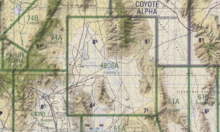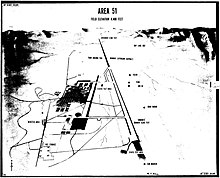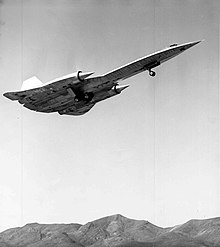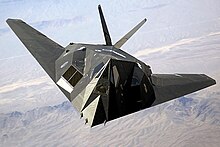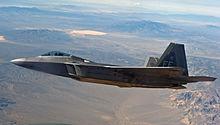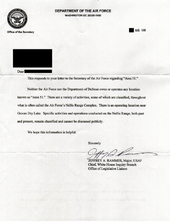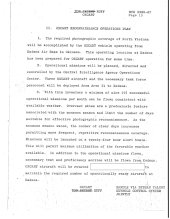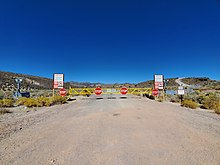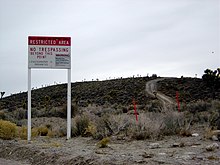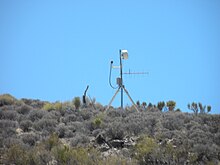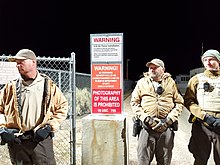Area 51 - Wikipedia
Zona 51
| Aeroporto di Homey | |||||||||||||||||
|---|---|---|---|---|---|---|---|---|---|---|---|---|---|---|---|---|---|
| Nei pressi di Rachel, Contea di Lincoln, Nevada in Stati Uniti | |||||||||||||||||
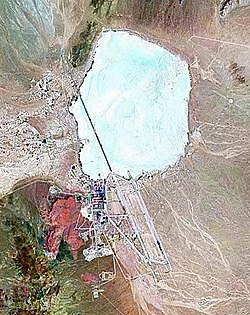
Un'immagine satellitare pseudocolore scattata nel 2000 che mostra la base con Groom Lake appena a nord-nord-est.
|
|||||||||||||||||
 |
|||||||||||||||||
| Coordinate | 37°14′0"N 115°48′30"WCoordinate: 37°14′0"N 115°48′30"W | ||||||||||||||||
| Digitare | Struttura della US Air Force | ||||||||||||||||
| Informazioni sul sito | |||||||||||||||||
| Proprietario | Dipartimento della Difesa | ||||||||||||||||
| Operatore | Aeronautica Militare degli Stati Uniti | ||||||||||||||||
| Controllato da | Comando Materiale dell'Aeronautica Militare | ||||||||||||||||
| Condizione | Operativo | ||||||||||||||||
| Storia del sito | |||||||||||||||||
| Costruito | 1955 (come Paradise Ranch) | ||||||||||||||||
| In uso | 1955 – oggi | ||||||||||||||||
| Avvenimenti | Area tempesta 51 (2019) | ||||||||||||||||
| Informazioni sulla guarnigione | |||||||||||||||||
| Guarnigione | Air Force Test Center (Distaccamento 3) | ||||||||||||||||
| Informazioni sull'aeroporto | |||||||||||||||||
| Identificatori | IATA: XTA[disputed ], ICAO: KXTA, FAA LID: XTA | ||||||||||||||||
| Elevazione | 4.494 piedi (1.370 m) s.l.m. | ||||||||||||||||
|
|||||||||||||||||
| Fonti: Jeppesen[1] | |||||||||||||||||
Area 51 è il nome comune di una struttura altamente classificata della United States Air Force (USAF) situata all'interno del Nevada Test and Training Range. Un distaccamento remoto amministrato dalla Edwards Air Force Base,la struttura è ufficialmente chiamata Homey Airport (XTA / KXTA)o Groom Lake[2] (dopo la salina situata accanto al suo aeroporto). I dettagli delle operazioni della struttura non sono resi pubblici, ma l'USAF afferma che si tratta di un campo di addestramento aperto,[3] ed è comunemente pensato per supportare lo sviluppo e il test di aerei sperimentali e sistemi d'arma. [4][3] L'USAF acquistò il sito nel 1955, principalmente per testare in volo il velivolo Lockheed U-2. [5]
L'intensa segretezza che circonda la base l'ha resa oggetto frequente di teorie cospirative e di una componente centrale del folklore degli oggetti volanti non identificati (UFO). [6][7] La base non è mai stata dichiarata una base segreta, ma tutte le ricerche e gli eventi nell'Area 51 sono Top Secret/Sensitive Compartmented Information (TS/SCI). [8] La CIA ha riconosciuto pubblicamente l'esistenza della base per la prima volta il 25 giugno 2013, a seguito di una richiesta del Freedom of Information Act (FOIA) presentata nel 2005 e, allo stesso tempo, ha declassificato documenti che dettagliano la storia e lo scopo dell'Area 51. [9]
L'Area 51 si trova nella parte meridionale del Nevada,a 83 miglia (134 km) a nord-nord-ovest di Las Vegas. L'area circostante è una popolare destinazione turistica, tra cui la piccola città di Rachel sulla "Extraterrestrial Highway".
Geografia
Zona 51
La base rettangolare originale di 6 per 10 miglia (9,7 per 16,1 km) è ora parte della cosiddetta "Groom box", un'area rettangolare che misura 23 per 25 miglia (37 per 40 km), di spazio aereo ristretto. L'area è collegata alla rete stradale interna del Nevada Test Site (NTS), con strade asfaltate che conducono a sud a Mercury e ad ovest a Yucca Flat. Conducendo a nord-est dal lago, l'ampia e ben tenuta Groom Lake Road attraversa un passo nelle Jumbled Hills. La strada in precedenza conduceva a miniere nel bacino di Groom, ma è stata migliorata dopo la loro chiusura. Il suo percorso tortuoso passa davanti a un punto di controllo di sicurezza, ma l'area riservata intorno alla base si estende più a est. Dopo aver lasciato l'area riservata, Groom Lake Road scende verso est fino al fondo della Valle del Tikaboo,passando gli ingressi sterrati di diversi piccoli ranch, prima di convergere con la State Route 375, la "Extraterrestrial Highway",a sud di Rachel. [10]
L'Area 51 condivide un confine con la regione Yucca Flat del Nevada Test Site, la posizione di 739 dei 928 test nucleari condotti dal Dipartimento dell'Energia degli Stati Uniti presso NTS. [11][12][13] Il deposito di scorie nucleari di Yucca Mountain si trova a sud-ovest di Groom Lake. [14]
Lago Groom
Groom Lake è una salina[15] in Nevada utilizzata per le piste dell'aeroporto Nellis Bombing Range Test Site (XTA / KXTA) a nord dell'installazione militare Area 51 USAF. Il lago a 4.409 piedi (1.344 m)[16] di altitudine è di circa 3,7 miglia (6,0 km) da nord a sud e 3 miglia (4,8 km) da est a ovest nel suo punto più largo. Situato all'interno dell'omonima porzione Groom Lake Valley del bacino di Tonopah,il lago si trova a 25 miglia (40 km) a sud di Rachel, Nevada. [17]
Storia
L'origine del nome "Area 51" non è chiara. Si ritiene che provenga da una rete di numerazione della Commissione per l'energia atomica (AEC), sebbene l'Area 51 non faccia parte di questo sistema; è adiacente all'Area 15. Un'altra spiegazione è che 51 è stato usato perché era improbabile che l'AEC usasse il numero. [18] Secondo la Central Intelligence Agency (CIA), i nomi corretti per la struttura sono Homey Airport (XTA / KXTA) e Groom Lake,[19][20] anche se il nome Area 51 è stato usato in un documento della CIA della guerra del Vietnam. [21] La struttura è stata anche indicata come Dreamland e Paradise Ranch,[22] tra gli altri soprannomi. Le pubbliche relazioni dell'USAF hanno fatto riferimento alla struttura come "una posizione operativa vicino a Groom Dry Lake". Lo spazio aereo ad uso speciale intorno al campo è indicato come Area riservata 4808 Nord (R-4808N). [23]
Piombo e argento furono scoperti nella parte meridionale della Groom Range nel 1864,[24] e la società inglese Groome Lead Mines Limited finanziò le Miniere di Conception nel 1870, dando al distretto il suo nome (le miniere vicine includevano Maria, Willow e White Lake). [25] J.B. Osborne e soci acquisirono la partecipazione di controllo in Groom nel 1876, e il figlio di Osbourne la acquistò nel 1890.[25] L'estrazione mineraria continuò fino al 1918, poi riprese dopo la seconda guerra mondiale fino ai primi anni 1950.[25]
L'aeroporto sul sito di Groom Lake iniziò il servizio nel 1942 come Indian Springs Air Force Auxiliary Field[26] e consisteva in due piste non asfaltate di 5.000 piedi (1.524 m). [27]
Programma U-2
La Central Intelligence Agency (CIA) istituì la struttura di prova di Groom Lake nell'aprile del 1955 per il Progetto AQUATONE: lo sviluppo del velivolo da ricognizione strategica Lockheed U-2. Il direttore del progetto Richard M. Bissell Jr. capì che i test di volo e i programmi di addestramento dei piloti non potevano essere condotti presso la Edwards Air Force Base o la struttura di Palmdale della Lockheed, data l'estrema segretezza che circonda il progetto. Ha condotto una ricerca di un sito di test adatto per l'U-2 sotto la stessa estrema sicurezza del resto del progetto. [28]: 25 Informò Lockheed, che inviò una squadra di ispezione a Groom Lake. Secondo il designer U-2 di Lockheed Kelly Johnson:[28] : 26
Il letto del lago costituiva una striscia ideale per testare gli aerei, e le catene montuose della Valle dell'Emigrante e il perimetro NTS proteggevano il sito dai visitatori; era a circa 100 miglia (160 km) a nord di Las Vegas. [29] La CIA chiese all'AEC di acquisire il terreno, designato "Area 51" sulla mappa, e di aggiungerlo al Nevada Test Site. [9]: 56–57
Johnson chiamò l'area "Paradise Ranch" per incoraggiare i lavoratori a trasferirsi nella "nuova struttura in mezzo al nulla", come la CIA in seguito la descrisse, e il nome fu abbreviato in "il Ranch". [9]: 57 Il 4 maggio 1955, una squadra di rilevamento arrivò a Groom Lake e dispose una pista nord-sud di 5.000 piedi (1.500 m) nell'angolo sud-ovest del letto del lago e designò un sito per una struttura di supporto alla base. Il Ranch inizialmente consisteva in poco più di qualche rifugio, officina e roulotte in cui ospitare la sua piccola squadra. [29] Poco più di tre mesi dopo, la base consisteva in un'unica pista pavimentata, tre hangar, una torre di controllo e sistemazioni rudimentali per il personale di prova. I pochi servizi della base includevano un cinema e un campo da pallavolo. C'era anche una sala mensa, diversi pozzi e serbatoi di stoccaggio del carburante. Il personale della CIA, dell'Air Force e della Lockheed iniziò ad arrivare nel luglio 1955. Il Ranch ricevette la sua prima consegna di U-2 il 24 luglio 1955 da Burbank su un aereo cargo C-124 Globemaster II, accompagnato da tecnici Lockheed su un Douglas DC-3. [29] I voli del Regular Military Air Transport Service furono istituiti tra l'Area 51 e gli uffici di Lockheed a Burbank,in California. Per preservare la segretezza, il personale volava in Nevada il lunedì mattina e tornava in California il venerdì sera. [9]: 72
Programma OXCART
Il progetto OXCART è stato istituito nell'agosto 1959 per "studi antiradar, test strutturali aerodinamici e progetti ingegneristici" e tutti i lavori successivi sul Lockheed A-12. [30] Ciò includeva test a Groom Lake, che aveva strutture inadeguate costituite da edifici per sole 150 persone, una pista di asfalto di 5.000 piedi (1.500 m) e carburante limitato, hangar e spazio commerciale. [28]: 58 Groom Lake aveva ricevuto il nome di "Area 51"[28]: 59 [31] quando la costruzione dell'impianto di prova A-12 iniziò nel settembre 1960, inclusa una nuova pista di 8.500 piedi (2.600 m) per sostituire la pista esistente. [32]
La Reynolds Electrical and Engineering Company (REECo) iniziò la costruzione del "Progetto 51" il 1º ottobre 1960 con programmi di costruzione a doppio turno. L'appaltatore ha aggiornato le strutture di base e costruito una nuova pista di 10.000 piedi (3.000 m) (14/32) in diagonale attraverso l'angolo sud-ovest del letto del lago. Hanno segnato una spirale archimedea sul lago asciutto di circa due miglia di diametro in modo che un pilota A-12 che si avvicinava alla fine del sovraccarico potesse abortire invece di immergersi nella salvia. I piloti dell'Area 51 lo chiamavano "The Hook". Per gli atterraggi con vento trasversale, hanno segnato due piste di atterraggio non asfaltate (piste 9/27 e 03/21) sul letto del lago asciutto. [33]
Nell'agosto 1961, la costruzione delle strutture essenziali era completa; tre hangar della Marina in eccesso furono eretti sul lato nord della base, mentre l'hangar 7 era di nuova costruzione. Gli hangar originali dell'U-2 furono convertiti in officine meccaniche e di manutenzione. Le strutture nell'area di cantonamento principale comprendevano officine ed edifici per lo stoccaggio e l'amministrazione, un commissario, una torre di controllo, una stazione dei pompieri e alloggi. La Marina ha anche contribuito con più di 130 unità abitative duplex Babbitt in eccesso per strutture di occupazione a lungo termine. Gli edifici più vecchi sono stati riparati e sono state costruite strutture aggiuntive se necessario. Un laghetto artificiale circondato da alberi fungeva da area ricreativa un miglio a nord della base. Altre strutture ricreative includevano una palestra, un cinema e un diamante da baseball. [33] All'inizio del 1962 fu costruita una fattoria permanente di serbatoi di carburante per aerei per lo speciale carburante JP-7 richiesto dall'A-12. Furono costruiti sette carri armati, con una capacità totale di 1.320.000 galloni. [28]: 58
La sicurezza è stata rafforzata per l'arrivo di OXCART e la piccola miniera è stata chiusa nel bacino di Groom. Nel gennaio 1962, la Federal Aviation Administration (FAA) espanse lo spazio aereo ristretto nelle vicinanze di Groom Lake, e il letto del lago divenne il centro di un'aggiunta di 600 miglia quadrate all'area riservata R-4808N. [33] La struttura della CIA ricevette otto F-101 Voodoo dell'USAF per l'addestramento, due addestratori T-33 Shooting Star per il volo esperto, un C-130 Hercules per il trasporto merci, un U-3A per scopi amministrativi, un elicottero per la ricerca e il soccorso e un Cessna 180 per uso di collegamento, e Lockheed fornì un F-104 Starfighter per l'uso come aereo da inseguimento. [33]
Il primo aereo di prova A-12 fu segretamente trasportato via da Burbank il 26 febbraio 1962 e arrivò a Groom Lake il 28 febbraio. [28]: 60 Ha fatto il suo primo volo il 26 aprile 1962 quando la base aveva oltre 1.000 persone. [28]: 60–62 Lo spazio aereo chiuso sopra Groom Lake era all'interno dello spazio aereo dell'Nellis Air Force Range, e i piloti videro l'A-12 da 20 a 30 volte. [28]: 63–64 Groom fu anche il sito del primo volo di prova del drone Lockheed D-21 il 22 dicembre 1964. [28]: 123 Alla fine del 1963, nove A-12 erano nell'Area 51, assegnati al "1129th Special Activities Squadron" operato dalla CIA. [34]
D-21 Tagboard
Dopo la perdita dell'U-2 di Gary Powerssull'Unione Sovietica, ci furono diverse discussioni sull'uso dell'A-12 OXCART come aereo drone senza pilota. Sebbene Kelly Johnson fosse venuto a sostenere l'idea della ricognizione dei droni, si oppose allo sviluppo di un drone A-12, sostenendo che l'aereo era troppo grande e complesso per una tale conversione. Tuttavia, l'Air Force accettò di finanziare lo studio di un aereo drone ad alta velocità e ad alta quota nell'ottobre 1962. L'interesse dell'Air Force sembra aver spinto la CIA ad agire, il progetto designato "Q-12". Nell'ottobre 1963, il progetto del drone era stato finalizzato. Allo stesso tempo, il Q-12 ha subito un cambio di nome. Per separarlo dagli altri progetti basati su A-12, è stato ribattezzato "D-21". (Il "12" è stato invertito in "21"). "Tagboard" era il nome in codice del progetto. [28]: 121
Il primo D-21 fu completato nella primavera del 1964 dalla Lockheed. Dopo altri quattro mesi di checkout e test statici, l'aereo è stato spedito a Groom Lake e rimontato. Doveva essere trasportato da un derivato biposto dell'A-12, designato "M-21". Quando il D-21/M-21 raggiunse il punto di lancio, il primo passo sarebbe stato quello di far saltare i coperchi di ingresso e scarico del D-21. Con il D-21/M-21 alla velocità e all'altitudine corrette, l'LCO avrebbe avviato il ramjet e gli altri sistemi del D-21. "Con i sistemi del D-21 attivati e in funzione, e l'aereo di lancio nel punto corretto, l'M-21 avrebbe iniziato un leggero pushover, l'LCO avrebbe premuto un pulsante finale e il D-21 si sarebbe staccato dal pilone". [28]: 122
Le difficoltà furono affrontate per tutto il 1964 e il 1965 a Groom Lake con vari problemi tecnici. I voli in cattività hanno mostrato difficoltà aerodinamiche impreviste. Alla fine di gennaio del 1966, più di un anno dopo il primo volo in cattività, tutto sembrava pronto. Il primo lancio del D-21 fu effettuato il 5 marzo 1966 con un volo di successo, con il D-21 che volò per 120 miglia con carburante limitato. Un secondo volo D-21 ebbe successo nell'aprile 1966 con il drone che volò per 1.200 miglia, raggiungendo Mach 3,3 e 90.000 piedi. Un incidente il 30 luglio 1966 con un D-21 completamente rifornito, su un volo di cassa pianificato, soffrì di un avvio del drone dopo la sua separazione, causandone la collisione con l'aereo di lancio M-21. I due membri dell'equipaggio sono stati espulsi e sono atterrati nell'oceano a 150 miglia al largo. Un membro dell'equipaggio è stato prelevato da un elicottero, ma l'altro, essendo sopravvissuto alla rottura e all'espulsione dell'aereo, è annegato quando l'acqua di mare è entrata nella sua tuta a pressione. Kelly Johnson ha personalmente cancellato l'intero programma, avendo avuto seri dubbi fin dall'inizio della fattibilità. Un certo numero di D-21 erano già stati prodotti, e piuttosto che demolire l'intero sforzo, Johnson propose nuovamente all'Air Force di essere lanciato da un bombardiere B-52H. [28]: 125
Alla fine dell'estate del 1967, il lavoro di modifica sia al D-21 (ora designato D-21B) che al B-52Hs era completo. Il programma di test potrebbe ora riprendere. Le missioni di prova sono state effettuate da Groom Lake, con i lanci effettivi sul Pacifico. Il primo D-21B ad essere pilotato fu l'Articolo 501, il prototipo. Il primo tentativo fu fatto il 28 settembre 1967 e si concluse con un completo fallimento. Mentre il B-52 stava volando verso il punto di lancio, il D-21B cadde dal pilone. Il B-52H ha dato un brusco slittamento mentre il drone cadeva libero. Il booster ha sparato ed è stato "piuttosto uno spettacolo da terra". Il guasto è stato ricondotto a un dado spogliato sul punto di attacco destro in avanti sul pilone. Sono stati fatti molti altri test, nessuno dei quali ha avuto successo. Tuttavia, il fatto è che le riprese dei test D-21 hanno avuto luogo in un contesto di ricognizione mutevole. L'A-12 era stato finalmente autorizzato a schierarsi e l'SR-71 lo sostituì presto. Allo stesso tempo, i nuovi sviluppi nella tecnologia satellitare da ricognizione si stavano avvicinando all'operazione. Fino a questo punto, il numero limitato di satelliti disponibili limitava la copertura dell'Unione Sovietica. Una nuova generazione di satelliti da ricognizione potrebbe presto coprire obiettivi in qualsiasi parte del mondo. La risoluzione dei satelliti sarebbe paragonabile a quella degli aerei, ma senza il minimo rischio politico. Il tempo stava per scadere per il Tagboard. [28]: 129
Diversi altri voli di prova, tra cui due sulla Cina,sono stati effettuati da Beale AFB,California, nel 1969 e nel 1970, con vari gradi di successo. Il 15 luglio 1971, Kelly Johnson ricevette un filo che annullava il programma D-21B. I droni rimanenti sono stati trasferiti da un C-5A e messi in deposito morto. Gli strumenti utilizzati per costruire i D-21B sono stati ordinati distrutti. Come l'A-12 Oxcart, i droni D-21B Tagboard sono rimasti un aereo nero, anche in pensione. La loro esistenza non fu sospettata fino all'agosto 1976, quando il primo gruppo fu messo in deposito presso il Davis-Monthan AFB Military Storage and Disposition Center. Un secondo gruppo arrivò nel 1977. Erano etichettati come "GTD-21Bs" (GT stava per allenamento a terra). [28]: 132
Davis-Monthan è una base aperta, con visite pubbliche dell'area di stoccaggio all'epoca, quindi i droni dall'aspetto strano sono stati presto individuati e le foto hanno iniziato ad apparire sulle riviste. Le speculazioni sui D-21B circolarono nei circoli dell'aviazione per anni, e non fu fino al 1982 che furono rilasciati i dettagli del programma Tagboard. Tuttavia, non è stato fino al 1993 che il programma B-52 / D-21B è stato reso pubblico. Nello stesso anno, i D-21B sopravvissuti furono rilasciati ai musei. [28]: 132–133
Valutazione delle tecnologie straniere
Durante la Guerra Fredda,una delle missioni svolte dagli Stati Uniti fu il test e la valutazione degli aerei da combattimento sovietici catturati. A partire dalla fine degli anni 1960, e per diversi decenni, l'Area 51 ha ospitato un assortimento di aerei di costruzione sovietica. Nell'ambito dei programmi HAVE DOUGHNUT, HAVE DRILL e HAVE FERRY, i primi MiG volati negli Stati Uniti sono stati utilizzati per valutare l'aereo in prestazioni, capacità tecniche e operative, mettendo i tipi contro i caccia statunitensi. [35]
Questa non era una nuova missione, poiché i test di tecnologia straniera da parte dell'USAF iniziarono durante la seconda guerra mondiale. Dopo la guerra, i test della tecnologia straniera acquisita sono stati eseguiti dall'Air Technical Intelligence Center (ATIC, che è diventatomolto influente durante la guerra di Corea ), sotto il comando diretto del Dipartimento di controllo del materiale aereo. Nel 1961, l'ATIC divenne la Foreign Technology Division (FTD) e fu riassegnata all'Air Force Systems Command. Il personale ATIC è stato inviato ovunque si potessero trovare aerei stranieri.
The focus of Air Force Systems Command limited the use of the fighter as a tool with which to train the front line tactical fighter pilots.[35] Air Force Systems Command recruited its pilots from the Air Force Flight Test Center at Edwards Air Force Base, California, who were usually graduates from various test pilot schools. Tactical Air Command selected its pilots primarily from the ranks of the Weapons School graduates.[35]
In August 1966, Iraqi Air Force fighter pilot Captain Munir Redfa defected, flying his MiG-21 to Israel after being ordered to attack Iraqi Kurd villages with napalm. His aircraft was transferred to Groom Lake in late 1967 for study. In 1968, the US Air Force and Navy jointly formed a project known as HAVE DOUGHNUT in which Air Force Systems Command, Tactical Air Command, and the U.S. Navy's Air Test and Evaluation Squadron Four (VX-4) flew this acquired Soviet made aircraft in simulated air combat training.[35] Because U.S. possession of the Soviet MiG-21 was, itself, secret, it was tested at Groom Lake. A joint Air Force-Navy team was assembled for a series of dogfight tests.[28]: 219
Comparisons between the F-4 and the MiG-21 indicated that, on the surface, they were evenly matched. The HAVE DOUGHNUT tests showed the skill of the man in the cockpit was what made the difference. When the Navy or Air Force pilots flew the MiG-21, the results were a draw; the F-4 would win some fights, the MiG-21 would win others. There were no clear advantages. The problem was not with the planes, but with the pilots flying them. The pilots would not fly either plane to its limits. One of the Navy pilots was Marland W. "Doc" Townsend, then commander of VF-121, the F-4 training squadron at NAS Miramar. He was an engineer and a Korean War veteran and had flown almost every navy aircraft. When he flew against the MiG-21, he would outmaneuver it every time. The Air Force pilots would not go vertical in the MiG-21. The HAVE DOUGHNUT project officer was Tom Cassidy, a pilot with VX-4, the Navy's Air Development Squadron at Point Mugu. He had been watching as Townsend "waxed" the Air Force MiG-21 pilots. Cassidy climbed into the MiG-21 and went up against Townsend's F-4. This time the result was far different. Cassidy was willing to fight in the vertical, flying the plane to the point where it was buffeting, just above the stall. Cassidy was able to get on the F-4's tail. After the flight, they realized the MiG-21 turned better than the F-4 at lower speeds. The key was for the F-4 to keep its speed up. An F-4 had defeated the MiG-21; the weakness of the Soviet plane had been found. Further test flights confirmed what was learned. It was also clear that the MiG-21 was a formidable enemy. United States pilots would have to fly much better than they had been to beat it. This would require a special school to teach advanced air combat techniques.[28]: 220–221
On 12 August 1968, two Syrian air force lieutenants, Walid Adham and Radfan Rifai, took off in a pair of MiG-17Fs on a training mission. They lost their way and, believing they were over Lebanon, landed at the Betzet Landing Field in northern Israel. (One version has it that they were led astray by an Arabic-speaking Israeli).[28] Prior to the end of 1968 these MiG-17s were transferred from Israeli stocks and added to the Area 51 test fleet. The aircraft were given USAF designations and fake serial numbers so that they could be identified in DOD standard flight logs. As in the earlier program, a small group of Air Force and Navy pilots conducted mock dogfights with the MiG-17s. Selected instructors from the Navy's Top Gun school at NAS Miramar, California, were chosen to fly against the MiGs for familiarization purposes. Very soon, the MiG-17's shortcomings became clear. It had an extremely simple, even crude, control system that lacked the power-boosted controls of American aircraft. The F-4's twin engines were so powerful it could accelerate out of range of the MiG-17's guns in thirty seconds. It was important for the F-4 to keep its distance from the MiG-17. As long as the F-4 was one and a half miles from the MiG-17, it was outside the reach of the Soviet fighter's guns, but the MiG was within reach of the F-4's missiles.[28]: 222–225
The data from the HAVE DOUGHNUT and HAVE DRILL tests were provided to the newly formed Top Gun school at NAS Miramar. By 1970, the HAVE DRILL program was expanded; a few selected fleet F-4 crews were given the chance to fight the MiGs. The most important result of Project HAVE DRILL is that no Navy pilot who flew in the project defeated the MiG-17 Fresco in the first engagement. The HAVE DRILL dogfights were by invitation only. The other pilots based at Nellis Air Force Base were not to know about the U.S.-operated MiGs. To prevent any sightings, the airspace above the Groom Lake range was closed. On aeronautical maps, the exercise area was marked in red ink. The forbidden zone became known as "Red Square".[28]: 226
During the remainder of the Vietnam War, the Navy kill ratio climbed to 8.33 to 1. In contrast, the Air Force rate improved only slightly to 2.83 to 1. The reason for this difference was Top Gun. The Navy had revitalized its air combat training, while the Air Force had stayed stagnant. Most of the Navy MiG kills were by Top Gun graduates[28]: 231
In May 1973, Project HAVE IDEA was formed which took over from the older HAVE DOUGHNUT, HAVE FERRY and HAVE DRILL projects and the project was transferred to the Tonopah Test Range Airport. At Tonopah, testing of foreign technology aircraft continued and expanded throughout the 1970s and 1980s.[35]
Area 51 also hosted another foreign materiel evaluation program called HAVE GLIB. This involved testing Soviet tracking and missile control radar systems. A complex of actual and replica Soviet-type threat systems began to grow around "Slater Lake", a mile northwest of the main base, along with an acquired Soviet "Barlock" search radar placed at Tonopah Air Force Station. They were arranged to simulate a Soviet-style air defense complex.[35]
The Air Force began funding improvements to Area 51 in 1977 under project SCORE EVENT. In 1979, the CIA transferred jurisdiction of the Area 51 site to the Air Force Flight Test Center at Edwards AFB, California. Mr. Sam Mitchell, the last CIA commander of Area 51, relinquished command to USAF Lt. Col. Larry D. McClain.[35]
Have Blue/F-117 program
The Lockheed Have Blue prototype stealth fighter (a smaller proof-of-concept model of the F-117 Nighthawk) first flew at Groom in December 1977.[36]
In 1978, the Air Force awarded a full-scale development contract for the F-117 to Lockheed Corporation's Advanced Development Projects. On 17 January 1981 the Lockheed test team at Area 51 accepted delivery of the first full-scale development (FSD) prototype 79–780, designated YF-117A. At 6:05 am on 18 June 1981 Lockheed Skunk Works test pilot Hal Farley lifted the nose of YF-117A 79–780 off the runway of Area 51.[37]
Meanwhile, Tactical Air Command (TAC) decided to set up a group-level organization to guide the F-117A to an initial operating capability. That organization became the 4450th Tactical Group (Initially designated "A Unit"), which officially activated on 15 October 1979 at Nellis AFB, Nevada, although the group was physically located at Area 51. The 4450th TG also operated the A-7D Corsair II as a surrogate trainer for the F-117A, and these operations continued until 15 October 1982 under the guise of an avionics test mission.[37]
Flying squadrons of the 4450th TG were the 4450th Tactical Squadron (Initially designated "I Unit") activated on 11 June 1981, and 4451st Tactical Squadron (Initially designated "P Unit") on 15 January 1983. The 4450th TS, stationed at Area 51, was the first F-117A squadron, while the 4451st TS was stationed at Nellis AFB and was equipped with A-7D Corsair IIs painted in a dark motif, tail coded "LV". Lockheed test pilots put the YF-117 through its early paces. A-7Ds were used for pilot training before any F-117As had been delivered by Lockheed to Area 51, later the A-7D's were used for F-117A chase testing and other weapon tests at the Nellis Range. On 15 October 1982, Major Alton C. Whitley Jr. became the first USAF 4450th TG pilot to fly the F-117A.[37]
Although ideal for testing, Area 51 was not a suitable location for an operational group, so a new covert base had to be established for F-117 operations.[38] Tonopah Test Range Airport was selected for operations of the first USAF F-117 unit, the 4450th Tactical Group (TG).[39] From October 1979, the Tonopah Airport base was reconstructed and expanded. The 6,000-foot runway was lengthened to 10,000 feet. Taxiways, a concrete apron, a large maintenance hangar, and a propane storage tank were added.[40]
By early 1982, four more YF-117As were operating at the base.[28]: 162 After finding a large scorpion in their offices, the testing team (Designated "R Unit") adopted it as their mascot and dubbed themselves the "Baja Scorpions".[41] Testing of a series of ultra-secret prototypes continued at Area 51 until mid-1981 when testing transitioned to the initial production of F-117 stealth fighters. The F-117s were moved to and from Area 51 by C-5 during darkness to maintain security. The aircraft were defueled, disassembled, cradled, and then loaded aboard the C-5 at night, flown to Lockheed, and unloaded at night before reassembly and flight testing. Groom performed radar profiling, F-117 weapons testing, and training of the first group of frontline USAF F-117 pilots.[28]: 161
While the "Baja Scorpions" were working on the F-117, there was also another group at work in secrecy, known as "the Whalers" working on Tacit Blue. A fly-by-wire technology demonstration aircraft with curved surfaces and composite material, to evade radar, was a prototype, and never went into production. Nevertheless, this strange-looking aircraft was responsible for many of the stealth technology advances that were used on several other aircraft designs, and had a direct influence on the B-2; with the first flight of Tacit Blue being performed on 5 February 1982, by Northrop Grumman test pilot, Richard G. Thomas.[28]: 249–250
Production FSD airframes from Lockheed were shipped to Area 51 for acceptance testing. As the Baja Scorpions tested the aircraft with functional check flights and L.O. verification, the operational airplanes were then transferred to the 4450th TG.[41]
On 17 May 1982, the move of the 4450th TG from Groom Lake to Tonopah was initiated, with the final components of the move completed in early 1983. Production FSD airframes from Lockheed were shipped to Area 51 for acceptance testing. As the Baja Scorpions tested the aircraft with functional check flights and L.O. verification, the operational airplanes were then transferred to the 4450th TG at Tonopah.[41]
The R-Unit was inactivated on 30 May 1989. Upon inactivation, the unit was reformed as Detachment 1, 57th Fighter Weapons Wing (FWW). In 1990, the last F-117A (843) was delivered from Lockheed. After completion of acceptance flights at Area 51 of this last new F-117A aircraft, the flight test squadron continued flight test duties of refurbished aircraft after modifications by Lockheed. In February/March 1992 the test unit moved from Area 51 to the USAF Palmdale Plant 42 and was integrated with the Air Force Systems Command 6510th Test Squadron. Some testing, especially RCS verification and other classified activity was still conducted at Area 51 throughout the operational lifetime of the F-117. The recently inactivated (2008) 410th Flight Test Squadron traces its roots, if not its formal lineage to the 4450th TG R-unit.[41]
Later operations
Since the F-117 became operational in 1983, operations at Groom Lake have continued. The base and its associated runway system were expanded, including the expansion of housing and support facilities.[20][42] In 1995, the federal government expanded the exclusionary area around the base to include nearby mountains that had hitherto afforded the only decent overlook of the base, prohibiting access to 3,972 acres (16.07 km2) of land formerly administered by the Bureau of Land Management.[20] On 22 October 2015, a federal judge signed an order giving land that belonged to a Nevada family since the 1870s to the United States Air Force for expanding Area 51. According to the judge, the land that overlooked the base was taken to address security and safety concerns connected with their training and testing.[43]
Legal status
U.S. government's positions on Area 51
The United States government has provided minimal information regarding Area 51. The area surrounding the lake is permanently off-limits to both civilian and normal military air traffic. Security clearances are checked regularly; cameras and weaponry are not allowed.[7] Even military pilots training in the NAFR risk disciplinary action if they stray into the exclusionary "box" surrounding Groom's airspace.[7] Surveillance is supplemented using buried motion sensors.[44] Area 51 is a common destination for Janet, a small fleet of passenger aircraft operated on behalf of the Air Force to transport military personnel, primarily from McCarran International Airport.[45]
The USGS topographic map for the area only shows the long-disused Groom Mine.[46] A civil aviation chart published by the Nevada Department of Transportation shows a large restricted area, defined as part of the Nellis restricted airspace.[47] The National Atlas shows the area as lying within the Nellis Air Force Base.[48] There are higher resolution and newer images available from other satellite imagery providers, including Russian providers and the IKONOS.[20] These show the runway markings, base facilities, aircraft, and vehicles.[20]
On 25 June 2013, the CIA released an official history of the U-2 and OXCART projects which acknowledged the existence of Area 51 in response to a Freedom of Information Act request submitted in 2005 by Jeffrey T. Richelson of George Washington University's National Security Archive. It contains numerous references to Area 51 and Groom Lake, along with a map of the area.[9][49][50][15]
Environmental lawsuit
In 1994, five unnamed civilian contractors and the widows of contractors Walter Kasza and Robert Frost sued the Air Force and the United States Environmental Protection Agency. They alleged that they had been present when large quantities of unknown chemicals had been burned in open pits and trenches at Groom. Rutgers University biochemists analyzed biopsies from the complainants and found high levels of dioxin, dibenzofuran, and trichloroethylene in their body fat. The complainants alleged that they had sustained skin, liver, and respiratory injuries due to their work at Groom and that this had contributed to the deaths of Frost and Kasza. The suit sought compensation for the injuries, claiming that the Air Force had illegally handled toxic materials and that the EPA had failed in its duty to enforce the Resource Conservation and Recovery Act which governs the handling of dangerous materials. They also sought detailed information about the chemicals, hoping that this would facilitate the medical treatment of survivors.[51] Congressman Lee H. Hamilton, former chairman of the House Intelligence Committee, told 60 Minutes reporter Lesley Stahl, "The Air Force is classifying all information about Area 51 in order to protect themselves from a lawsuit."[52]
The government invoked the State Secrets Privilege and petitioned U.S. District Judge Philip Pro to disallow disclosure of classified documents or examination of secret witnesses, claiming that this would expose classified information and threaten national security.[53] Judge Pro rejected the government's argument, so President Bill Clinton issued a Presidential Determination exempting what it called "the Air Force's Operating Location Near Groom Lake, Nevada" from environmental disclosure laws. Consequently, Pro dismissed the suit due to lack of evidence. Turley appealed to the U.S. Court of Appeals for the Ninth Circuit on the grounds that the government was abusing its power to classify material. Secretary of the Air Force Sheila E. Widnall filed a brief which stated that disclosures of the materials present in the air and water near Groom "can reveal military operational capabilities or the nature and scope of classified operations." The Ninth Circuit rejected Turley's appeal[54] and the U.S. Supreme Court refused to hear it, putting an end to the complainants' case.[51]
The President annually issues a determination continuing the Groom exception[55][56][57] which is the only formal recognition that the government has ever given that Groom Lake is more than simply another part of the Nellis complex. An unclassified memo on the safe handling of F-117 Nighthawk material was posted on an Air Force web site in 2005. This discussed the same materials for which the complainants had requested information, which the government had claimed was classified. The memo was removed shortly after journalists became aware of it.[58]
Civil aviation identification
In December 2007, airline pilots noticed that the base had appeared in their aircraft navigation systems' latest Jeppesen database revision with the ICAO airport identifier code of KXTA and listed as "Homey Airport".[59] The probably inadvertent release of the airport data led to advice by the Aircraft Owners and Pilots Association (AOPA) that student pilots should be explicitly warned about KXTA, not to consider it as a waypoint or destination for any flight even though it now appears in public navigation databases.[59]
Security
The perimeter of the base is marked out by orange posts and patrolled by guards in white pickup trucks and camouflage fatigues. The guards are popularly referred to as "cammo dudes" by enthusiasts.[60][61] The guards will not answer questions about their employers; however, according to the New York Daily News, there are indications they are employed through a contractor such as AECOM.[61][62] Signage around the base perimeter advises that deadly force is authorized against trespassers.[63]
Technology is also heavily used to maintain the border of the base; this includes surveillance cameras and motion detectors. Some of these motion detectors are placed some distance away from the base on public land to notify guards of people approaching.[64]
1974 Skylab photography
Dwayne A. Day published "Astronauts and Area 51: the Skylab Incident" in The Space Review in January 2006. It was based on a memo written in 1974 to CIA director William Colby by an unknown CIA official. The memo reported that astronauts on board Skylab had inadvertently photographed a certain location.[65]
The name of the location was obscured,[b] but the context led Day to believe that the subject was Groom Lake. Day argues that "the CIA considered no other spot on Earth to be as sensitive as Groom Lake".[65][67] The memo details debate between federal agencies regarding whether the images should be classified, with Department of Defense agencies arguing that it should and NASA and the State Department arguing that it should not be classified. The memo itself questions the legality of retroactively classifying unclassified images.[65]
The memo includes handwritten remarks,[68] apparently by Director of Central Intelligence Colby:
The declassified documents do not disclose the outcome of discussions regarding the Skylab imagery. The debate proved moot, as the photograph appeared in the Federal Government's Archive of Satellite Imagery along with the remaining Skylab photographs.[69]
2019 shooting incident
On January 28, 2019, an unidentified man drove through a security checkpoint near Mercury, Nevada, in an apparent attempt to enter the base. After an 8-mile (13-kilometer) vehicle pursuit by base security, the man exited his vehicle carrying a "cylindrical object" and was shot dead by NNSS security officers and sheriff's deputies after refusing to obey requests to halt. There were no other injuries reported.[70][71]
UFO and other conspiracy theories
Area 51 has become a focus of modern conspiracy theories due to its secretive nature and connection to classified aircraft research.[8] Theories include:
- The storage, examination, and reverse engineering of crashed alien spacecraft, including material supposedly recovered at Roswell, the study of their occupants, and the manufacture of aircraft based on alien technology
- Meetings or joint undertakings with extraterrestrials
- The development of exotic energy weapons for the Strategic Defense Initiative (SDI) or other weapons programs
- The development of weather control
- The development of time travel and teleportation technology
- The development of exotic propulsion systems related to the Aurora Program
- Activities related to a shadowy one-world government or the Majestic 12 organization
Many of the hypotheses concern underground facilities at Groom or at Papoose Lake (also known as "S-4 location"), 8.5 miles (13.7 km) south, and include claims of a transcontinental underground railroad system, a disappearing airstrip nicknamed the "Cheshire Airstrip", after Lewis Carroll's Cheshire cat, which briefly appears when water is sprayed onto its camouflaged asphalt, and engineering based on alien technology.[72]
In the mid-1950s, civilian aircraft flew under 20,000 feet while military aircraft flew up to 40,000 feet. The U-2 began flying above 60,000 feet and there was an increasing number of UFO sighting reports. Sightings occurred most often during early evening hours, when airline pilots flying west saw the U-2's silver wings reflect the setting sun, giving the aircraft a "fiery" appearance. Many sighting reports came to the Air Force's Project Blue Book, which investigated UFO sightings, through air-traffic controllers and letters to the government. The project checked U-2 and later OXCART flight records to eliminate the majority of UFO reports that it received during the late 1950s and 1960s, although it could not reveal to the letter writers the truth behind what they saw.[9]: 72–73 Similarly, veterans of experimental projects such as OXCART at Area 51 agree that their work inadvertently prompted many of the UFO sightings and other rumors:[73]
They believe that the rumors helped maintain secrecy over Area 51's actual operations.[7] The veterans deny the existence of a vast underground railroad system,[74] although many of Area 51's operations did occur underground.[75]
Bob Lazar affermò nel 1989 di aver lavorato nel "Settore Quattro (S-4)" dell'Area 51, che si dice si trovasse sottoterra all'interno della Papoose Range vicino al lago Papoose. Ha affermato di essere stato incaricato di lavorare con veicoli spaziali alieni che il governo aveva in suo possesso. [76] Allo stesso modo, il documentario del 1996 Dreamland diretto da Bruce Burgess includeva un'intervista con un ingegnere meccanico di 71 anni che sosteneva di essere un ex dipendente dell'Area 51 durante gli anni 1950. Le sue affermazioni includevano che aveva lavorato su un "simulatore di dischi volanti" che era stato basato su un disco proveniente da un veicolo extraterrestre precipitato ed era stato utilizzato per addestrare i piloti. Affermò anche di aver lavorato con un essere extraterrestre di nome "J-Rod" e descritto come un "traduttore telepatico". [77] Nel 2004, Dan Burisch (pseudonimo di Dan Crain) affermò di aver lavorato alla clonazione di virus alieni nell'Area 51, anche insieme all'alieno di nome "J-Rod". Le credenziali accademiche di Burisch sono oggetto di molti dibattiti, poiché apparentemente lavorava come ufficiale di libertà vigilata a Las Vegas nel 1989 mentre consegreva anche un dottorato di ricerca presso la State University di New York (SUNY). [78]
Nel luglio 2019, più di 2.000.000 di persone hanno risposto a una proposta scherzosa per assaltare l'Area 51 che è apparsa in un post anonimo di Facebook.[79][80][81] L'evento, previsto per il 20 settembre 2019, è stato pubblicizzato come "Storm Area 51, They Can't Stop All of Us", un tentativo di "vederli alieni". [82][83] La portavoce dell'Air Force Laura McAndrews ha detto che il governo "scoraggerebbe chiunque dal cercare di entrare nell'area in cui addestramo le forze armate americane". [3] Due festival musicali nelle zone rurali del Nevada, "AlienStock" e "Storm Area 51 Basecamp", sono stati successivamente organizzati per capitalizzare la popolarità dell'evento originale di Facebook. Tra 1.500 e 3.000 persone si sono presentate ai festival, mentre oltre 150 persone hanno fatto il viaggio su diversi chilometri di strade accidentate per avvicinarsi ai cancelli dell'Area 51. [84][85] Sette persone sarebbero state arrestate durante l'evento. [84]





